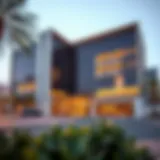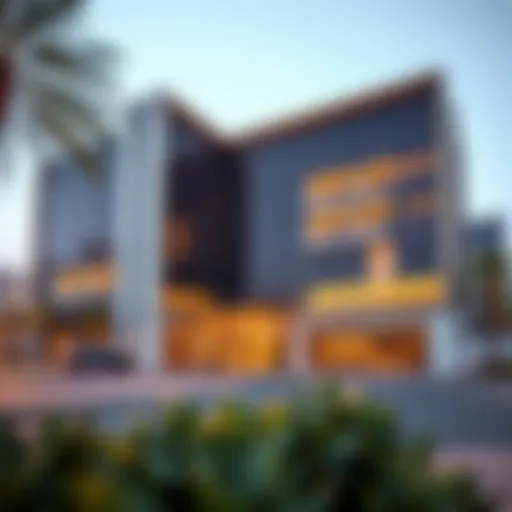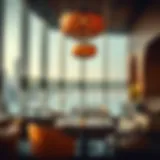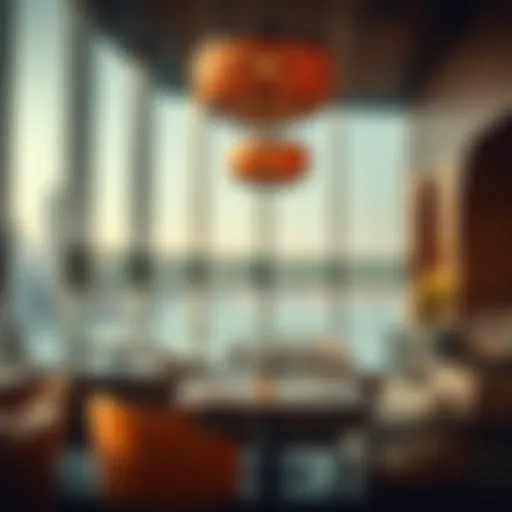Exploring the Dubai Metro Green Line Stations
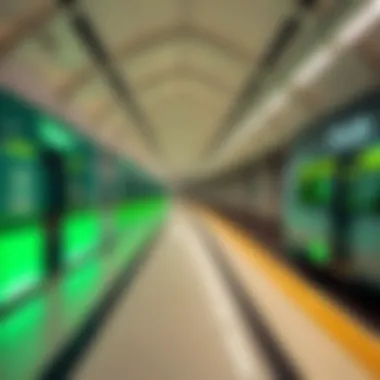

Intro
Navigating a city as dynamic as Dubai requires an understanding of its intricate transport network. One of the key arteries in this network is the Dubai Metro Green Line. Established as a vital link within the rapidly evolving urban fabric, the Green Line connects numerous key areas of the city, enhancing accessibility for commuters ranging from residents to business professionals.
As Dubai expands, the significance of efficient transport systems also grows. The Green Line, which traverses a variety of neighborhoods, acts as a lifeline, easing transit through both bustling commercial zones and tranquil residential areas. From the more traditional districts to those on the cutting edge of modern living, understanding the stations along this line is essential for anyone looking to navigate or invest in Dubai's vibrant real estate market.
This article will unfold the Green Line's stations, diving into their locations and the neighborhoods they touch. Furthermore, insights into the market trends and investment opportunities arising from these areas will be explored. The aim is clear: to equip readers with crucial knowledge for navigating Dubai's ever-evolving transportation landscape.
Market Trends and Analysis
In the realm of public transport, the anlysis of market trends can paint a vivid picture of the direction of urban development. The Dubai Metro Green Line is certainly no exception to this rule. As new stations are brought to life and surrounding areas undergo transformation, the implications for residents and investors are profound.
Current Market Overview
The introduction of the Green Line has reshaped the commuting experience in Dubai. Today, the landscape around its stations reflects a growing market characterized by rising demand for convenience and accessibility. Neighborhoods alongside the metro line are experiencing a surge in development, drawing the attention of both local buyers and expatriates looking to make the most of the city’s offerings. Prices of properties near these stations have often reflected this increased interest, as the convenience of metro access cannot be underestimated.
Moreover, with the influx of businesses setting up shop near these stations, commercial properties are seeing a favorable rise in value too. Areas like Al Jaddaf and Dubai Healthcare City are witnessing increasing investments due to their proximity to the metro.
Future Market Predictions
Looking ahead, trends suggest that the value of properties near the Green Line is only poised to rise. As the city continues to grow, areas such as these are likely to become even more sought after. In fact, experts predict that certain neighborhoods previously overlooked could transform into prime real estate hotspots.
For investors, understanding these trends can be the critical edge needed to make informed decisions. A close study of which stations are boosting local development can yield insights not only into property values but also into overall urban planning objectives.
"The growth along the Green Line is a testament to Dubai's forward-thinking approach to urban mobility and infrastructure development."
Investment Opportunities
Emerging Neighborhoods
The stations along the Green Line serve as gateways to emerging neighborhoods ripe for investment. Areas like Al Quoz, known for their artsy vibe, or Meydan, increasingly popular for its residential offerings, are just two examples. As these neighborhoods continue to develop, more amenities and facilities are introduced, making them appealing for both families and professionals alike.
Types of Properties for Investment
Investors exploring the potential of the Green Line should consider various property types, ranging from:
- Apartments: Ideal for young professionals and families, often in high demand.
- Commercial Properties: Particularly near stations like BurJuman and Union, attracting retailers and service businesses.
- Mixed-use Developments: These spaces combine residential and commercial elements, encouraging lifestyle options that cater to modern needs.
This comprehensive understanding of the Green Line network not only informs daily life but also positions individuals to seize opportunities in a city that is constantly evolving. Investors and homebuyers alike, armed with knowledge, can navigate this landscape with greater confidence.
Preamble to Dubai Metro Green Line
The Dubai Metro Green Line is much more than a mere transit route; it is the lifeblood of urban mobility in one of the world's fastest-growing cities. The Green Line offers a crucial connection between various key districts, making it an essential part of daily commutes for residents, tourists, and expatriates alike. Its role extends beyond just transportation; it facilitates economic growth, promotes sustainable commuting options, and adds to Dubai’s reputation as a forward-thinking metropolis.
In this section, we delve into the history of the Dubai Metro and its significance, showcasing why the Green Line stands out as a pivotal artery within the city’s transport network.
History of the Dubai Metro
The inception of the Dubai Metro dates back to the early 2000s when the government of Dubai identified the need for a modern public transport system. Officially launched in September 2009, the Metro's Green Line opened in April 2011, marking true progress in the emirate's ambitious urban development plan. The initial concept centered around reducing road congestion and providing an environmentally-friendly alternative to traditional transportation methods.
The project had its fair share of challenges—from land acquisition and funding to overcoming engineering difficulties in constructing underground stations. However, through persistence and planning, the Green Line’s construction drew to a successful completion.
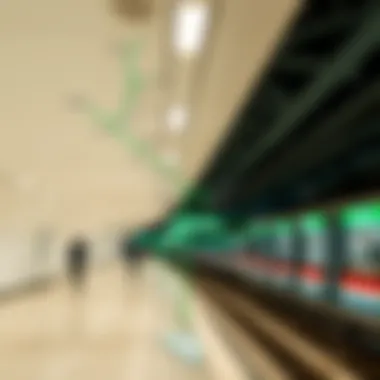

Significance of the Green Line
The Green Line serves multiple pivotal functions in Dubai's urban fabric. Firstly, it connects diverse neighborhoods, enhancing accessibility to residential areas, business districts, and cultural hotspots. This has led to a surge in foot traffic and a sense of community in connected locales.
Additionally, by alleviating traffic congestion, the Green Line contributes significantly to reducing carbon emissions. Many commuters have transitioned to this efficient mode of travel, thereby promoting a sustainable lifestyle in Dubai.
The Green Line is often viewed as a reflection of Dubai's vision for a visionary smart city. It encourages smart mobility, integrated transport options, and bolstered economic activity in its vicinity, bringing enormous benefits to property values and fostering new investments in real estate development.
"The Dubai Metro is not just about trains, it's about creating an interconnected, thriving ecosystem for present and future generations."
In summary, the Dubai Metro Green Line is an indispensable thread in the tapestry of Dubai's public transport system. It has transformed the way residents and visitors navigate the city, paving the way for future innovations in transit solutions. As we continue dissecting this monumental infrastructure project, we will explore the route and specifics of each station it serves.
Overview of the Green Line Route
The Dubai Metro Green Line is more than just a transport option; it’s a vital artery running through the heart of the city. This line interconnects a multitude of neighborhoods, residential areas, and commercial hubs, making it indispensable for both residents and visitors. Understanding its route offers valuable insights into not just the journey but the very fabric of urban life in Dubai.
Total Length and Coverage
Spanning approximately 23 kilometers, the Green Line takes riders on a scenic route stretching from the northern areas of Dubai down south. With 20 stations dotted along its path, the Green Line offers unparalleled access to key districts like Al Jaddaf, Healthcare City, and beyond. Each station is thoughtfully positioned to facilitate easy access to both residential and commercial spaces.
Moreover, the line cuts through a diversely populated mix of neighborhoods, ranging from upscale residential developments to bustling businesses. This comprehensive coverage shapes how people commute daily, reducing traffic congestion and promoting public transport over personal vehicles.
In terms of geographical footprint, the metro runs from Etisalat Metro Station to Jebel Ali Station, meandering its way through Dubai Healthcare City and Al Jaddaf.
The strategic planning behind this coverage not only enhances the city’s mobility but also encourages pedestrian-friendly environments in areas adjacent to the stations. People are likely to frequent local shops and services, fostering a community atmosphere, making venues like cafes and boutiques accessible in a quick hop.
Interconnections with Other Lines
The connectivity offered by the Green Line further amplifies its significance within Dubai's transport network. It seamlessly links with the Red Line at both the BurJuman and Union stations, creating a robust transit system that enhances the overall commuter experience. This interconnectivity minimizes travel time across the city and makes transitioning between different areas smooth and efficient.
Moreover, the future expansion plans hint at further integrations with upcoming transit lines, which can only bolster the role of the Green Line as a pivotal connector in the metropolis.
In summary, the Green Line not only represents a method of getting from point A to B; it encapsulates a vision of a modern city where transport systems are integrated with urban life itself. The line stands as a testament to Dubai's commitment towards creating a sustainable, efficient, and user-friendly public transport experience, making it an invaluable asset for current and future residents as well as investors.
List of Green Line Stations
The Green Line of the Dubai Metro is not just a series of stops; it’s a lifeline connecting various parts of this bustling metropolis. Each station along the Green Line carries its own significance, serving as a gateway for countless individuals to commute, whether they are living in Dubai or just visiting. Understanding the list of stations is crucial for investors, homeowners, expatriates, and analysts who are keen to explore the potential of surrounding neighborhoods and assess real estate value.
Al Ghez, Al Khaleej Center
Situated right in the heart of the action, Al Ghez station offers access to the Al Khaleej Center, a hub for shopping and commercial activities. This station is pivotal for both the daily commuter and tourists alike. The nearby retail options present a variety of shops, which can draw steady foot traffic. Such exposure is beneficial for potential investors looking at commercial real estate. Moreover, the station's proximity to prominent hotel chains makes it a convenient stop for visitors as well.
Al Jadaf
Al Jadaf station is a point of interest for those connected to the cultural and artistic sectors. Positioned close to the Dubai Cultural Village, it attracts both locals and tourists keen on art and heritage. The surrounding areas are seeing significant development, which signals growth potential. For investors, this means a chance to tap into an evolving market. The station enhances connectivity, making it easier for residents in nearby areas to access cultural amenities and leisure activities.
Al Wasl
Strategically placed, the Al Wasl station caters to a blend of residential and business districts. This station serves a diverse community, from families to young professionals. Nearby amenities, such as schools and dining options, make it a desirable location for homeowners. The increased demand for residence in this area further suggests that real estate values could be on the rise, providing opportunities for wise investment decisions.
Dubai Healthcare City
As the name suggests, the Dubai Healthcare City station is at the forefront of medical and health services in the region. This station connects passengers to a sprawling complex that boasts hospitals, clinics, and wellness centers, which are crucial for both residents and expatriates. With the healthcare sector experiencing robust growth, the area around this station is increasingly attractive for businesses related to health services and professional practices. Investors should take note of the area’s continued expansion plans.
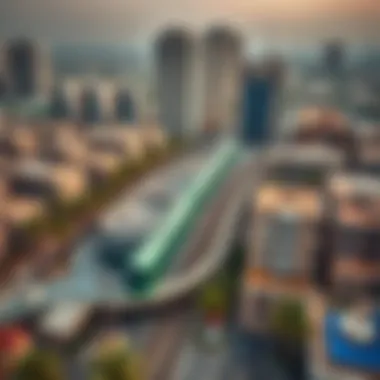

Dubai Investments Park
Dubai Investments Park station is a key link for those engaged in business activities. Located adjacent to the industrial area, this station supports the needs of professionals in sectors ranging from logistics to manufacturing. The station simplifies access to the park's economic zones, where companies can thrive with the infrastructure and resources available. This is also appealing for real estate development aimed at workers in these sectors.
Jebel Ali
Jebel Ali station is a major transport hub due to its connection to the largest sea port in the Middle East. This area is the backbone of trade and commerce in Dubai. Its significance is not lost on investors looking for industrial and logistics opportunities. With evolving trends in global commerce, Jebel Ali's real estate market is likely to benefit from ongoing development efforts and increased activity in the logistics sector, making it well worth the consideration of potential homeowners and business owners alike.
Umm Suqeim
Umm Suqeim station offers unique access to some of Dubai’s picturesque beaches and tourist destinations. This makes it a prime spot for both expatriates and tourists. The lifestyle here is laid-back but vibrant, with plenty of dining and recreational options. The station’s surroundings are generally high-value in terms of real estate, appealing to investors who wish to enter the upscale market. Nearby attractions add to the area's desirability, ensuring robust interest.
Riyadh
While Riyadh station may not be universally recognized as one of the major attractions, it plays a steady role in connecting neighborhoods and commercial zones. This station supports a mix of residential and business functionality, creating foot traffic that benefits local businesses. For those analyzing the market, the station can represent a stable investment opportunity that reinforces community ties. As the neighborhoods around it develop, the station will likely gain importance in regional transport planning.
The Green Line isn’t just about getting from A to B; it’s about connecting people to their communities and opportunities.
Each station along the Dubai Metro's Green Line serves a unique purpose, bridging luxury, commerce, and culture. Understanding these dynamics can assist potential investors and residents in making well-informed decisions.
Impact on Surrounding Neighborhoods
The establishment of the Dubai Metro Green Line has significantly influenced the neighborhoods it traverses. This development is not just about transport—it serves as a catalyst for economic vitality and urban growth in the regions surrounding the stations. Understanding these impacts provides insights into the broader socio-economic changes, making it crucial for potential investors, homeowners, and expatriates to grasp the dynamics at play here.
Real Estate Trends Near Green Line Stations
The Green Line's influence on real estate trends is undeniable. Locations adjacent to the metro stations have seen a notable surge in property values. For instance, residential units near Al Jadaf have surged in demand, as homebuyers look for convenience in commuting. The appeal of living close to public transport can’t be overstated. As urban planning continues to align with public transport routes, these areas are becoming increasingly favorable for investment.
- Rising Property Values: The increase in demand often correlates with elevated prices in both residential and commercial properties.
- New Developments: Construction projects are on the rise, as developers rush to capitalize on the anticipated growth in these neighborhoods. High-rise apartments and mixed-use buildings are popping up like daisies in spring.
- Changing Demographics: As young professionals and expatriates flock to these areas for ease of access to the metro, the demographic profile is shifting notably.
These factors are interlinked with the metro's reach; as accessibility improves, so does desirability. Both investors and homeowners must keep a keen eye on real estate fluctuations in these hubs.
Economic Development in Connected Areas
Apart from real estate, the Green Line boosts economic development in its surrounding areas. This is manifested through a variety of channels:
- Local Businesses: Increased foot traffic leads to heightened visibility for local shops, restaurants, and services. Small businesses have begun to flourish, thereby transforming once-sleepy neighborhoods into bustling commercial hubs.
- Job Creation: The influx of new residents and customers has sparked job opportunities. From retail positions to service jobs in hospitality and administration, the job market is expanding, benefiting the local economy.
- Investment Attraction: With improved transport links, investors are more willing to pour funds into these neighborhoods, seeing them as viable, thriving locales for business ventures.
"Investment opportunity tends to follow connectivity," a phrase that rings true in this scenario. New establishments—be it a cozy café or a high-end retail outlet—are not just sprouting up in response to demand; they are actively reshaping the economic landscape.
Future Developments Along the Green Line
The future developments along the Dubai Metro Green Line are pivotal for ensuring that this vital transport network continues to meet the fast-paced growth of the city. As Dubai expands and evolves, the need for efficient public transportation becomes more pronounced. New stations and upgrades not only promise to enhance connectivity but also serve as a catalyst for economic prosperity in the area. Understanding these developments allows investors and residents to comprehend the potential benefits and opportunities emerging from this dynamic landscape.
Planned Stations and Extensions
There are exciting plans on the horizon for additional stations and extensions along the Green Line. The Dubai government has been actively investing in infrastructure, which in turn supports urban development. Some anticipated stations include extensions towards Al Quoz and areas bordering the UAE Exchange, which are poised to enhance accessibility for both residents and businesses.
These new stations will potentially include:
- Al Quoz: A hub that can connect industrial zones to the metro, making commutes easier for workers and enhancing local business foot traffic.
- Al Furjan: With many new developments in this area, it’s expected that a station will cater to the growing population.
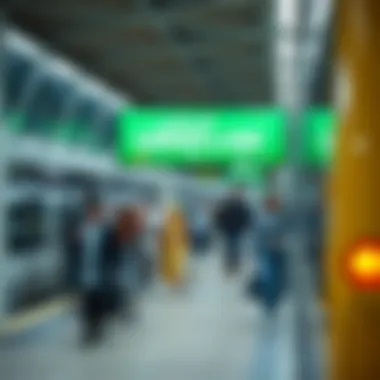

This extension would not only improve transport efficiency but also integrate communities that have been somewhat isolated due to the previous limitations of the metro. Commuter convenience is likely to explode as these options become reality.
Investment Opportunities Arising
With the prospect of new stations and the flow of traffic they bring, clear investment opportunities are emerging. For example, the areas surrounding proposed stations like Al Quoz and Al Furjan are expected to see significant jumps in property values as demand rises. Investors are wise to take notice, as these zones could provide excellent returns as public transport accessibility improves.
Investing in commercial and residential properties near these upcoming stations may offer lucrative advantages:
- Commercial space: Offices or retail shops near metro stations tend to attract consistent foot traffic, ideal for businesses aiming for visibility.
- Residential projects: Developers are more likely to seek out land for housing projects close to these stations, which would draw families and young professionals eager to benefit from convenient transport links.
Additionally, the increase in connectivity between diverse neighborhoods will not only uplift property values but also contribute to the overall economy of Dubai, making it a tempting area for both local and international investors. The continuous focus on enhancing transportation infrastructure lays a solid foundation for prosperous ventures.
"The expansion of the Dubai Metro is not just about adding lines; it’s about transforming lives and shaping communities across the city."
As developments progress and planned stations come to fruition, stakeholders across various sectors should remain alert to capitalize on the momentum created by the Green Line. Keeping an ear to the ground regarding these expansions will be essential for those who wish to maximize opportunities within Dubai’s vibrant and lucrative property market.
Challenges Faced by the Green Line
The Dubai Metro Green Line, despite its pivotal role in enhancing public transportation in the city, encounters several challenges that can affect its operational and economic efficiency. Addressing these issues is crucial not only for current passengers but also for investors and future planners interested in the long-term viability of public transit solutions in Dubai. In this section, we’ll delve into the operational efficiency issues and passenger connectivity challenges that need careful consideration to ensure the Green Line’s continued success.
Operational Efficiency Issues
Operational efficiency is the backbone of any effective public transport system. For the Green Line, maintaining a balance between frequency, punctuality, and capacity is vital in ensuring that it meets the daily demands of its users. One of the primary challenges is the aging of certain infrastructure. Over time, some of the components may not function as smoothly as they once did, leading to service disruptions.
Additionally, increased passenger numbers can strain the system. For example, during peak hours, the trains can become overcrowded, leading to potential delays. If more people are crammed into a confined space, the system finds it hard to meet its safety regulations.
Uneven train frequency can also stir frustration among riders. Long waiting times between trains can deter potential users from opting for the metro over personal vehicles, reducing the overall efficacy of the service. Overall, meeting the operational standards expected by both residents and tourists is critical for the line’s reputation and user satisfaction.
"An efficient metro system is only as good as its ability to adapt to the growing needs of the city it serves."
Passenger Connectivity Challenges
While the Green Line is designed to serve various neighborhoods and vital locations, ensuring seamless connectivity becomes a multifaceted challenge. One of the main obstacles is the physical accessibility of stations. Not all stations are optimally located with regard to local bus routes, making it tricky for passengers to complete their journeys without a seamless transfer.
Furthermore, there can be a lack of clear direction signage at multiple points, making it difficult for new users, like expats or tourists, to navigate confidently. Simple navigation becomes complicated when stops are not clearly marked or connections aren't well communicated.
The interconnectivity with other lines, while generally efficient, does require some additional travel time, especially when stations aren't adjacent. Therefore, some might find the alternative travel route a hassle rather than a boon. This situation reflects the necessity for improved integration strategies between different transport modes, ensuring that using the metro remains an appealing choice for everyone.
In summary, tackling these operational and connectivity challenges is crucial to guarantee that the Green Line continues to cater effectively to the growing population and diverse travel needs of Dubai residents.
Culmination
The significance of the Dubai Metro Green Line emerges as a vital thread in the city's grand tapestry of urban development and modern transport. This metro line is not merely a mode of commuting; it represents a cornerstone for the future of public transportation in Dubai, encapsulating accessibility, efficiency, and sustainability.
Summary of Key Insights
When taking a step back to overview the Green Line, several critical points drive home its importance:
- Connectivity: Each station along the line functions as a gateway, linking the sprawling neighborhoods of Dubai. This eases access to business districts, residential quarters, and recreational areas, meeting the needs of both seasoned locals and new expatriates.
- Economic Implications: The ripple effect of the Green Line on economic growth cannot be overstated. Properties in proximity to stations typically experience a surge in demand, which is of particular interest to investors and homeowners alike. The interaction between transport and real estate has continually shaped the urban landscape, reinforcing the relationship between mobility and economic activity.
- Environmental Benefits: Public transport systems inherently promote sustainability. The Green Line reduces traffic congestion and lowers carbon emissions, aligning with Dubai's commitment to fostering a greener future and tapping into a wider global movement towards environmental responsibility.
The Future of Transport in Dubai
Looking forward, the evolution of transport in Dubai appears promising.
- Expansion Plans: The ongoing development of additional stations within the Green Line will enhance network efficiency and encourage economic growth in underdeveloped areas. There is a keen focus on integrating urban planning with transport developments, ensuring lines serve emerging neighborhoods.
- Technological Integration: Future enhancements likely involve the incorporation of smart technologies, streamlining operations and improving passenger experience. AI-driven systems will likely facilitate better service delivery and maintenance, making commuting smoother and more responsive.
- Diversification of Transport Options: Alongside the metro system, initiatives for bicycles and pedestrian pathways are gaining traction, providing a multifaceted approach to urban mobility that complements the Green Line's existing capabilities. This; in turn, could lead to a holistic transport ecosystem ready to adapt to the city's evolving demands.
"The Dubai Metro Green Line is not just a transit line; it symbolizes a city's commitment to progress and sustainability."
In summary, the future of the Dubai Metro's Green Line brings with it exciting potential not only for improving urban mobility but also for influencing the city’s development trajectory. Engaging with these updates offers insight into how the dynamics of transport affect every facet of life in this bustling metropolis.
